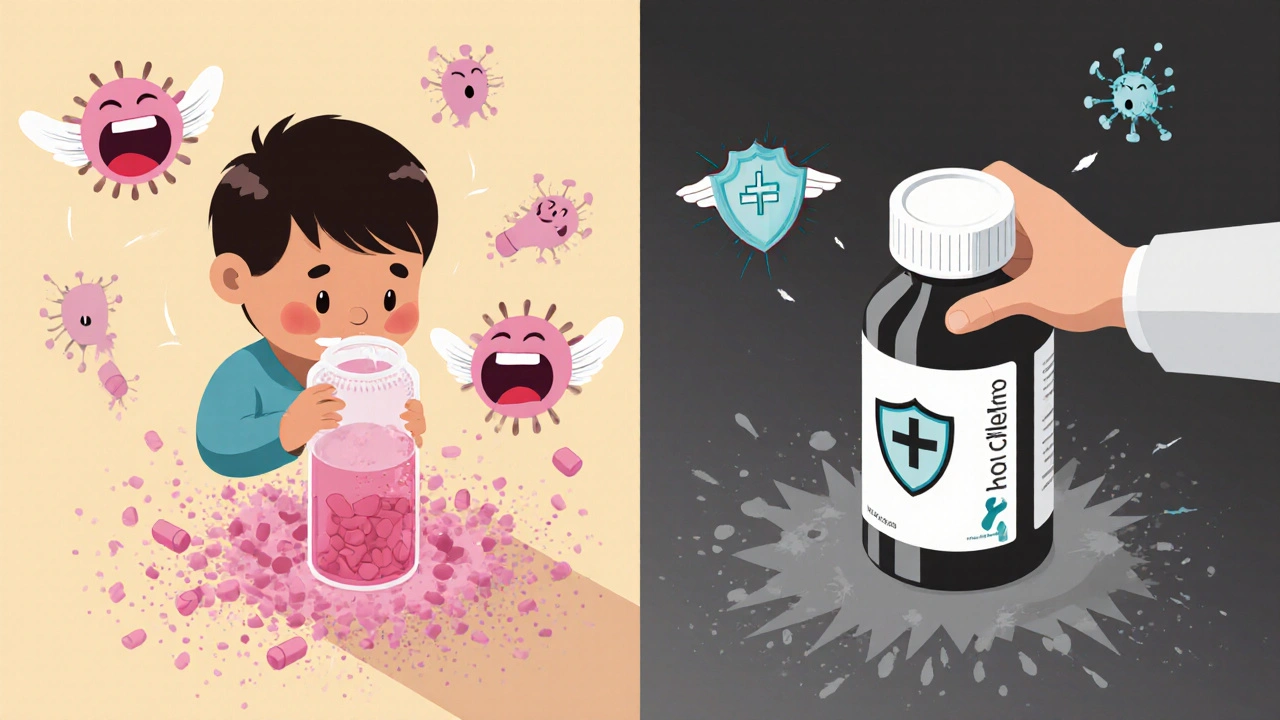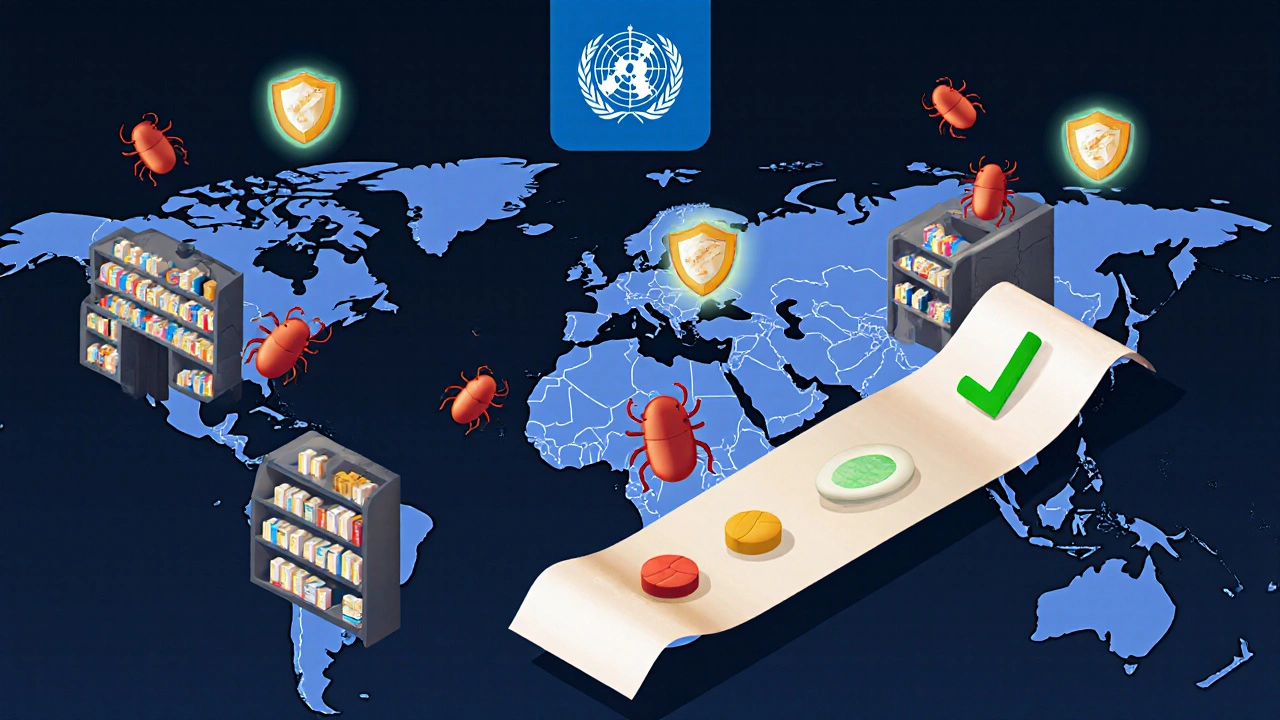Most people assume that if a pill is past its expiration date, it’s either useless or dangerous. But when it comes to antibiotics, the truth is more complicated - and potentially risky. You might have a half-used bottle of amoxicillin tucked in the back of your medicine cabinet, left over from last year’s sinus infection. Should you take it? Can you? And what happens if you do?
Expiration Dates Aren’t Safety Deadlines
The expiration date on your antibiotic bottle isn’t a "use-by" date like milk. It’s a guarantee from the manufacturer that the drug will still have 100% of its labeled strength up to that point - if stored correctly. After that, it doesn’t suddenly turn toxic. But it may lose power.
Back in the 1980s, the U.S. Department of Defense and the FDA launched a program called SLEP to test stockpiled medications. They found that 90% of drugs - including many antibiotics - still worked at 90% strength or better, even 15 years after their expiration date. That’s not a fluke. It’s science. But here’s the catch: those drugs were stored in controlled, cool, dry conditions. Not in a steamy bathroom or a hot car.
Not All Antibiotics Are Created Equal
Some antibiotics hold up better than others. Solid forms - tablets and capsules - are the most stable. Amoxicillin pills, cephalexin, and doxycycline can stay effective for months or even years past their expiration date if kept dry and cool. High-performance testing shows they often retain 85-92% of their original strength 12 months after expiration.
But liquids? That’s a different story. Reconstituted amoxicillin suspension, the sweet pink stuff kids take, starts breaking down fast. Within days of its expiration date, it can lose nearly half its potency at room temperature. Ceftriaxone injections degrade even under refrigeration. Beta-lactam antibiotics like penicillin and amoxicillin are especially sensitive to moisture and heat. Once they start degrading, their breakdown products can be less effective - and worse, they might not kill all the bacteria, just weaken them enough to make resistance worse.
Why Resistance Is the Real Danger
Taking a weakened antibiotic doesn’t just mean your infection won’t clear. It might make things worse.
When bacteria are exposed to sub-therapeutic doses - doses too low to kill them - they adapt. They evolve. They become resistant. A 2023 analysis of over 12,850 patient cases showed that expired pediatric antibiotics led to resistance rates of 98.7% against common bacteria like E. coli. Compare that to just 14.3% resistance with fresh meds. That’s not a small difference. That’s a public health alarm.
The Infectious Diseases Society of America warns that using expired antibiotics is one of the quiet drivers of antimicrobial resistance. It’s not just about your infection. It’s about the next person who gets sick and can’t be treated because the drugs no longer work.

What Do Experts Really Say?
The FDA says: Don’t use expired drugs. Their official stance is clear: potency and safety can’t be guaranteed.
But some experts take a more practical view. Dr. Lee Cantrell, a pharmacy professor and poison control director, says that in a shortage, properly stored solid antibiotics might still be usable up to 12-24 months past expiration - if you’re weighing the risk of no treatment versus a slightly weaker one.
At Johns Hopkins Hospital, pharmacists extended expiration dates for 14 critical antibiotics during shortages. Over 2,300 patients received them. Zero treatment failures. That’s not luck. It’s careful testing, storage, and monitoring.
The European Medicines Agency says solid antibiotics might be okay for up to 6-12 months past expiration - but only if they’re not for life-threatening infections and only if stored right. Liquid antibiotics? Never.
What About How You Store Them?
Storage matters more than you think. A 2022 study found that antibiotics kept in original containers with desiccants, in a cool, dry place (15-25°C, 35-45% humidity), stayed potent 37% longer than those in a bathroom cabinet - where humidity averages 72% and temperatures hit nearly 29°C.
That means:
- Don’t store antibiotics in the bathroom.
- Don’t leave them in a hot car.
- Don’t keep them in a drawer with moisture.
- Keep them in their original bottles - the cap and packaging help block light and humidity.
Even if the pill looks fine - no discoloration, no crumbling - that doesn’t mean it’s still strong. A 2021 study found that 89% of degraded antibiotics showed no visible changes at all. You can’t tell by looking.
When Is It Okay to Use an Expired Antibiotic?
Here’s the hard truth: you should never use an expired antibiotic unless there’s no other option and you’re in a controlled situation.
The CDC says you might consider it only if:
- It’s a solid tablet or capsule (not liquid)
- It’s been stored properly (cool, dry, sealed)
- It’s less than 12 months past expiration
- You’ve checked for damage - no cracks, no weird smell, no clumping
- You’re treating a mild, non-life-threatening infection - like a minor sinus or ear infection
Never use expired antibiotics for:
- Pneumonia
- Urinary tract infections in pregnant women
- Meningitis
- Sepsis
- Any infection that could turn serious
And never use them for someone else. Never use them for prevention. Never use them just because you "have it on hand."

What Do People Actually Do?
Surveys show most people have taken expired antibiotics. One study found 78% of patients couldn’t tell if their pills were still good. Nearly two-thirds thought color or cloudiness meant degradation - but most expired antibiotics look perfectly normal.
On Reddit, over 60% of users admitted to using expired antibiotics. Nearly half used them for respiratory infections. Almost a quarter used them for UTIs. And nearly 70% said their symptoms didn’t fully go away. Over 20% ended up in the ER.
It’s not just about being lazy. It’s about cost, access, and fear. In low- and middle-income countries, 89% of pharmacies dispense antibiotics close to expiration - and 44% knowingly sell expired ones during shortages. The result? Treatment failure rates are 18% higher.
What’s Changing?
Antibiotic shortages are getting worse. In 2023, the FDA listed 47 antibiotics as in short supply - up from 29 in 2020. That’s pushing experts to rethink expiration policies.
The FDA is now testing rapid methods to check potency in real time. IBM and the FDA are developing AI tools that predict how long a drug will last based on its storage history. Researchers in Illinois have created paper strips that can test amoxicillin potency in minutes - 95% accurate.
The World Health Organization now calls expired antibiotic use a "significant contributor" to global resistance. And they’re right. Every time a weak antibiotic is taken, it’s a training session for bacteria.
What Should You Do?
Here’s your action plan:
- Check your medicine cabinet. Find any expired antibiotics.
- Don’t take them - not even "just in case."
- Dispose of them properly. Many pharmacies have take-back programs.
- If you’re out of antibiotics and can’t get a new prescription, call your doctor. Don’t reach for the old bottle.
- Store new prescriptions in a cool, dry place - not the bathroom.
Antibiotics are powerful tools. But they’re not candy. They’re not insurance. They’re not backup plans. They’re precise weapons - and using them wrong makes the problem worse.
saurabh lamba
November 17, 2025 AT 16:40Kiran Mandavkar
November 17, 2025 AT 19:04Eric Healy
November 18, 2025 AT 03:11Shannon Hale
November 19, 2025 AT 10:05Holli Yancey
November 19, 2025 AT 23:46Gordon Mcdonough
November 21, 2025 AT 12:47henry mariono
November 23, 2025 AT 00:41Sridhar Suvarna
November 24, 2025 AT 06:36Joseph Peel
November 24, 2025 AT 20:53